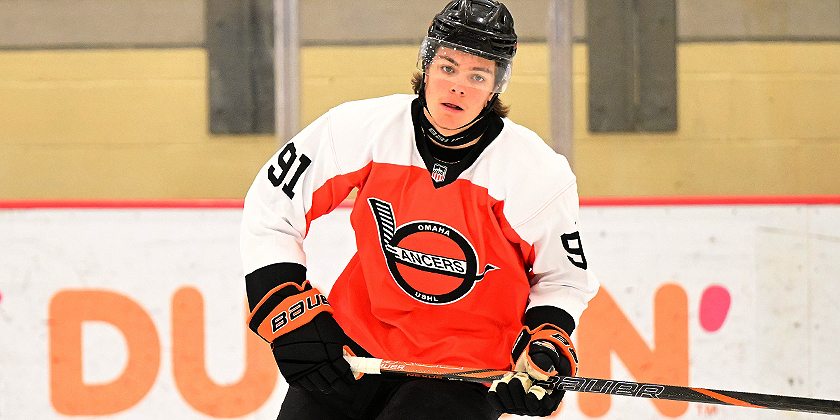
Nicolas Sykora (C, L, 6’0″, 175, Sioux City Musketeers, 05/24/2007, Quinnipiac)
Strengths: Why Sykora Should Be Drafted
- Offensive Growth and Playmaking Improvements
Significant improvement post-trade to Sioux City, where he has elevated his offensive output from 0.41 PPG in Omaha to 1.00 PPG in Sioux City.
Strong passer and playmaker, completing 89% of his passes with a solid 0.67 passes per game leading to shots—indicating effective offensive zone vision.
Consistently generates scoring chances, averaging 2 Grade “A” opportunities per game – a consistent ability to get into prime scoring areas. - Mobility and Offensive Zone Awareness
Excellent offensive zone positioning, with over 50% of his ice time spent in the offensive zone, showing strong instincts to find soft spots and maintain possession.
Effective skating ability – creates time and space to distribute the puck or get shots off under pressure. - Defensive Awareness and Puck Retrieval
High-end takeaway numbers (3.3 per game) – strong hands, anticipation and ability to read plays defensively.
Strong loose puck recovery numbers (1.64 per game) demonstrate high-end puck anticipation and positioning in the offensive zone. - Improved Production and Transition Play
Drastic improvement after the trade, showing adaptability and confidence when put in a system that suits his offensive style.
Thrives in transition, moving pucks effectively and pushing pace with strong puck management.
Weaknesses: Why Sykora Might Not Be Drafted
- Lack of Physical Engagement and Battle Wins
Only 0.43 hard hits per game – a reluctance to engage physically despite playing in high-traffic areas.
Wins only 44% of his 50/50 puck battles, which is below average for a top-line USHL forward – he can be outmuscled in contested situations. - Puck Management and Turnovers
Too many giveaways (5 per game)—for an offensively skilled player, puck protection skills will need refinement before advancing to higher levels.
Decision-making under pressure can be inconsistent, leading to turnovers in key moments. - Finishing Ability and Shot Utilization
Scores on only 13% of Grade “A” chances, which is too low for a top-six offensive forward— he needs to improve shot deception, release, and ability to finish in tight.
Attempts 4 shots per game but only 2.4 hit the net – he needs better shot selection and accuracy.
Final Verdict: Draftable or Not?
Projected Mid-to-Late Round Pick (4th-6th Round)
Why Draft Him?
Versatile offensive forward with strong playmaking ability.
Significant improvement post-trade suggests adaptability and growth potential.
Skates well and processes the game quickly in transition.
Shows strong puck anticipation and ability to recover loose pucks.
Why Not Draft Him?
Needs to improve physicality and battle level to win more contested pucks.
Turnovers are a concern; puck management under pressure must improve.
Finishing ability is below average—needs to become more of a scoring threat.
Projection:
Best-Case NHL Upside: Middle-six offensive winger with strong playmaking ability.
Most Likely Path: Develops at the NCAA level or in the CHL before transitioning to pro hockey.
Draft Range: 4th-6th Round—has offensive upside but will need focused development to his game, especially his strength, puck management, and finishing ability, to have a realistic NHL path.
Conclusion:
Sykora has shown tremendous offensive growth since his trade to Sioux City, proving he can produce and drive offense when given a bigger role. However, his lack of physical engagement, below-average finishing, and tendency for giveaways are areas that must be improved. If he can add strength, refine his shot, and limit turnovers, he has the potential to be a strong playmaking winger at the pro level.
Photo credit: Dan Hickling/Hickling Images
